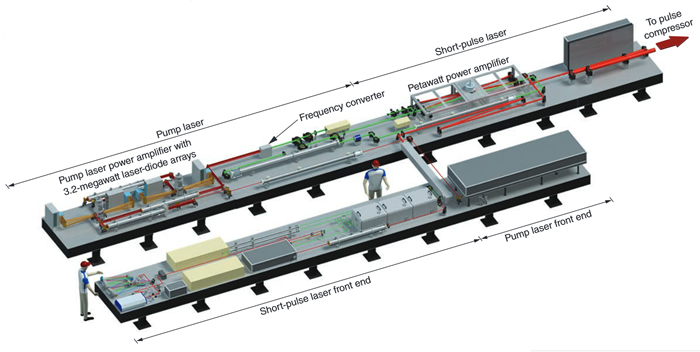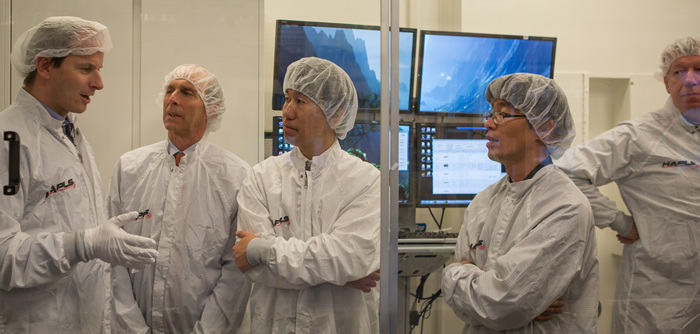Science & Technology - 2016
January
HAPLS Passes a Key Milestone
The High-Repetition-Rate Advanced Petawatt Laser System (HAPLS) under construction at LLNL recently achieved a key average power milestone more than two months ahead of schedule, and is now moving into the next phase in its development.
The HAPLS high-energy diode-pumped solid-state pump laser, firing at a repetition rate of 3.3 Hz (3.3 shots per second), achieved 70 joules of infrared (1,053-nanometer) energy and 39 joules of green (527-nm) energy. Completion of this average-power milestone marks another major setp in the HAPLS commissioning plan: beginning of integrating the pump laser with the HAPLS high-energy short-pulse beamline.
 HAPLS team members (clockwise from left) Constantin Haefner, Jiri Thoma, James Nissen (sitting), Pavel Bakule, and Bedrich Rus review the results of pump laser commissioning tests in the HAPLS control room. Credit: Jason Laurea
HAPLS team members (clockwise from left) Constantin Haefner, Jiri Thoma, James Nissen (sitting), Pavel Bakule, and Bedrich Rus review the results of pump laser commissioning tests in the HAPLS control room. Credit: Jason Laurea “Ramping the pump laser to this intermediary performance level was an important step for HAPLS,” said Constantin Haefner, program director for Advanced Photon Technologies. “For the first time we ran the pump laser at significant energy and average power levels, meeting and exceeding the required goals for this milestone. This accomplishment required a huge team effort and the team worked extremely hard to make this happen.
“We are taking a risk-balanced approach in ramping HAPLS to its full performance,“ he said. “The data we collected confirmed our performance models and gave the green light to start integration with the short-pulse beamline before ramping to even higher power levels.”
Representatives from the European Union’s Extreme Light Infrastructure Beamlines (ELI-Beamlines) facility in the Czech Republic, where HAPLS will be installed, attended the demonstration. “We are delighted to see the HAPLS pump laser work with a performance exceeding the project expectations for this phase, and achieve this important milestone on budget and ahead of schedule,” said ELI Beamlines Chief Laser Scientist Bedrich Rus. “The partnership with LLNL has been a tremendously successful story, and this demonstration shows the robustness of the underlying design and technology. The L3 (HAPLS) beamline will be ELI Beamlines’ user facility workhorse.”
 This computer-aided design shows HAPLS’ two interconnected Livermore-developed laser systems. The diode-pumped, solid-state pump laser will deliver up to 200 joules of energy at a repetition rate of 10 Hz. At the pump laser output, a frequency converter doubles the laser frequency from infrared to green. The solid-state, short-pulse laser converts the energy from the pump laser to 30-joule, 30-femtosecond pulses for a peak power exceeding one petawatt. The laser system measures just 4.6 meters wide and 17 meters long.
This computer-aided design shows HAPLS’ two interconnected Livermore-developed laser systems. The diode-pumped, solid-state pump laser will deliver up to 200 joules of energy at a repetition rate of 10 Hz. At the pump laser output, a frequency converter doubles the laser frequency from infrared to green. The solid-state, short-pulse laser converts the energy from the pump laser to 30-joule, 30-femtosecond pulses for a peak power exceeding one petawatt. The laser system measures just 4.6 meters wide and 17 meters long. HAPLS is designed to reach a peak power exceeding one petawatt at a repetition rate of 10 times per second to deliver intensities on target up to 1023 watts per square centimeter. Achieving this intensity would open up entirely new areas of laser–matter investigation, enable new applications of laser-driven x rays and particles, and for the first time allow researchers to study laser interactions with the sea of virtual particles that comprise a vacuum.
Ramping of the laser to its full performance has been organized in several phases. The first phase, completed last October, brought the pump laser to an intermediate performance level in a “single shot” regime, as opposed to an average power regime in which the amplifiers are thermally loaded. “In the second phase,” Haefner said, “we brought it up to average power, and that was an intermediate performance level. And now we’re integrating the pump laser and the short-pulse system. Together with ELI Beamlines we will integrate the short-pulse performance diagnostics, and then we will ramp the short-pulse laser system, similar to what we did for the pump laser system, first to energy and then to average power.”
“The reason for the phased approach,” said Systems Architect and Commissioning Manager Andy Bayramian, “is that we operate the laser at the intermediate performance level, learn how to operate it, identify operational challenges and input-data errors if they exist, and once we have gained operational experience, then we ramp it to its full performance.”
The engineering of the HAPLS laser combines many disciplines to produce a high-quality design. Electrical, mechanical, optical, precision, controls, vacuum, and infrastructure engineering teams have contributed to deliver the required components for a fully functional laser. “Diodes and pulsers, optical mounts and actuators, custom optics, the software control system, large vacuum vessels and vacuum system, and cooling gas and water delivery systems all have been assembled, installed, qualified and functionally demonstrated in the delivery of our latest milestone,” said HAPLS Project Engineer Jeff Horner. “The engineering accomplishments enable the laser to be consistently run at its design point.”
An ELI Beamlines team visited LLNL to observe the pump laser operating and meeting its specifications, and an international peer review committee was invited to the Laboratory to assess the results to date as well as the project’s scalability to its full performance requirements. HAPLS is designed to allow for future upgrades and scaling to even higher energies and repetition rates, which will ensure the longevity and scientific competitiveness of the ELI Beamlines facility.
 Constantin Haefner (left) briefs members of the international peer review panel that assessed the performance of HAPLS for the ELI Beamlines team during their Nov. 19 visit to LLNL: (from left) Peter Moulton of the MIT Lincoln Lab, Hiromitsu Kiryama of the Japanese Atomic Energy Agency, Seong Ku Lee of the Advanced Photonics Research Insititute, Korea, and Bedrich Rus of Eli Beamlines. Credit: Jason Laurea
Constantin Haefner (left) briefs members of the international peer review panel that assessed the performance of HAPLS for the ELI Beamlines team during their Nov. 19 visit to LLNL: (from left) Peter Moulton of the MIT Lincoln Lab, Hiromitsu Kiryama of the Japanese Atomic Energy Agency, Seong Ku Lee of the Advanced Photonics Research Insititute, Korea, and Bedrich Rus of Eli Beamlines. Credit: Jason Laurea “HAPLS will allow its users for the first time to approach the commercial applications arena for laser-generated secondary sources,” Haefner said. “There’s no other laser which actually can produce sufficient average power of the high-intensity light required for commercial applications.”
The system’s pulses will be used to generate extremely bright and short x-ray pulses for imaging cells and proteins at unprecedented spatial and temporal resolution. Another application is generating bunches of protons or ions for medical therapy and materials science research. Scientists also will study the interaction of intense laser light with matter to improve understanding of high energy density science.



